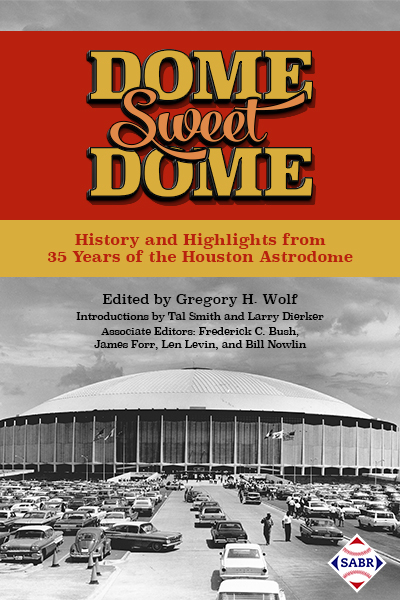Larry Dierker: A Look Back at the Astrodome
This article was written by Larry Dierker
This article was published in Dome Sweet Dome: History and Highlights from 35 Years of the Houston Astrodome
 As a Little Leaguer in Southern California, I was thrilled when the Dodgers moved to Los Angeles. I saw a few games at the Coliseum, but when I went to Dodger Stadium for the first time, I thought I was in heaven.
As a Little Leaguer in Southern California, I was thrilled when the Dodgers moved to Los Angeles. I saw a few games at the Coliseum, but when I went to Dodger Stadium for the first time, I thought I was in heaven.
Six years later I pitched a game at Old Colt Stadium in Houston on my 18th birthday. We could all see the Astrodome across the parking lot, the steel beams and the arching roof structure. I don’t think any of us could have imagined what it would look like when we got back from spring training the next year.
Our team bus pulled into the Astrodome parking lot under the veil of darkness on April 7, 1965. The roof was aglow. We really couldn’t appreciate the beauty of the outside walls until the next day. But of course, the inside was the thing anyway. We entered the stadium and walked across the concourse into the box seats. It was breathtaking. The colors of the theater-style seats on each level were eye-popping. The scoreboard was gigantic. The grass was green, the dirt brown, and the field was chalked brilliant white. Although jaws dropped, it must have been at least a minute before anyone said anything. Wow!
Dodger Stadium was a relic; it was Old Colt Stadium. We were in the 21st century.
I pitched in an intrasquad game the next day and gave up a bunch of runs because the glare of the sun through the Lucite panels of the roof made it impossible for fielders to track fly balls. The next night we hosted the Yankees and Mickey Mantle hit the first home run, off Turk Farrell. Little did we know at the time, a home run to center field (or in any other direction) would be quite an accomplishment in the Dome.
Attendance was good for the first few years as people (not all of them baseball fans), came to Houston from the four corners of the earth to see what Astros owner Roy Hofheinz proclaimed to be the Eighth Wonder of the World. Indeed, he had been inspired by the Colosseum in Rome and had returned from an excursion to Europe with many architectural elements and other furnishings that he would use to embellish the Astrodome Club, the Domeskeller behind the outfield wall, and the Sky Boxes high atop the upper deck.
As you will learn, many historic events formed a timeline of the Astrodome’s history. And if efforts to restore the building are successful, there may be more to come. But what I find ironic is that, in a way, the Astrodome in Houston led businessmen and politicians in many other cities right down the primrose path.
Once it was clear that grass would not grow inside, Astroturf was invented to replace it. It was yet another wonder. Who could fail to notice that both football and baseball could be played in the same stadium without the necessity of mowing the lawn. Soon there were convertible multipurpose stadiums with Astroturf in St. Louis, Cincinnati, Pittsburgh, and Philadelphia. A few other cities built convertible bowls with natural grass. But after 20 years or so, it became obvious that these venues were not ideal for football or baseball. And they were anything but charming. Camden Yards was built to bring back the feel of the “old ballpark.” Then a succession of retro-style fields began replacing the big bowls. When the 21st century actually arrived, the Astros moved out of the Astrodome and into Enron Field, a retro park, in downtown Houston.
Looking back, the Astrodome’s place in baseball history is similar to that of Shibe Park in Philadelphia, which started the trend of big baseball-only stadiums in 1909. After that, nine new ballparks were built in the next six years for major-league teams. Among them, only Fenway Park and Wrigley Field remain. I got to play at Wrigley and in Crosley Field, Sportsman’s Park, Forbes Field, and Connie Mack Stadium. And though I missed the Polo Grounds by a year, I feel the progress of baseball and its environs in my bones.
LARRY DIERKER debuted for the Houston Colt 45s on his 18th birthday in 1964. In his 14-year big-league career, the two-time All-Star right-hander originally from Californian went 139-123, spending all but his final campaign with Houston. After retiring, he served as color commentator on Astros radio and television broadcasts from 1979 to 1996. In 1997 he left the broadcast booth for the dugout, and guided the Astros to the NL West Division Crown. In 1998 he was named the NL Manager of Year. In his five years skipper, the Astros finished in first place five times. As of 2015 he served as Special Assistant to the Astros.


